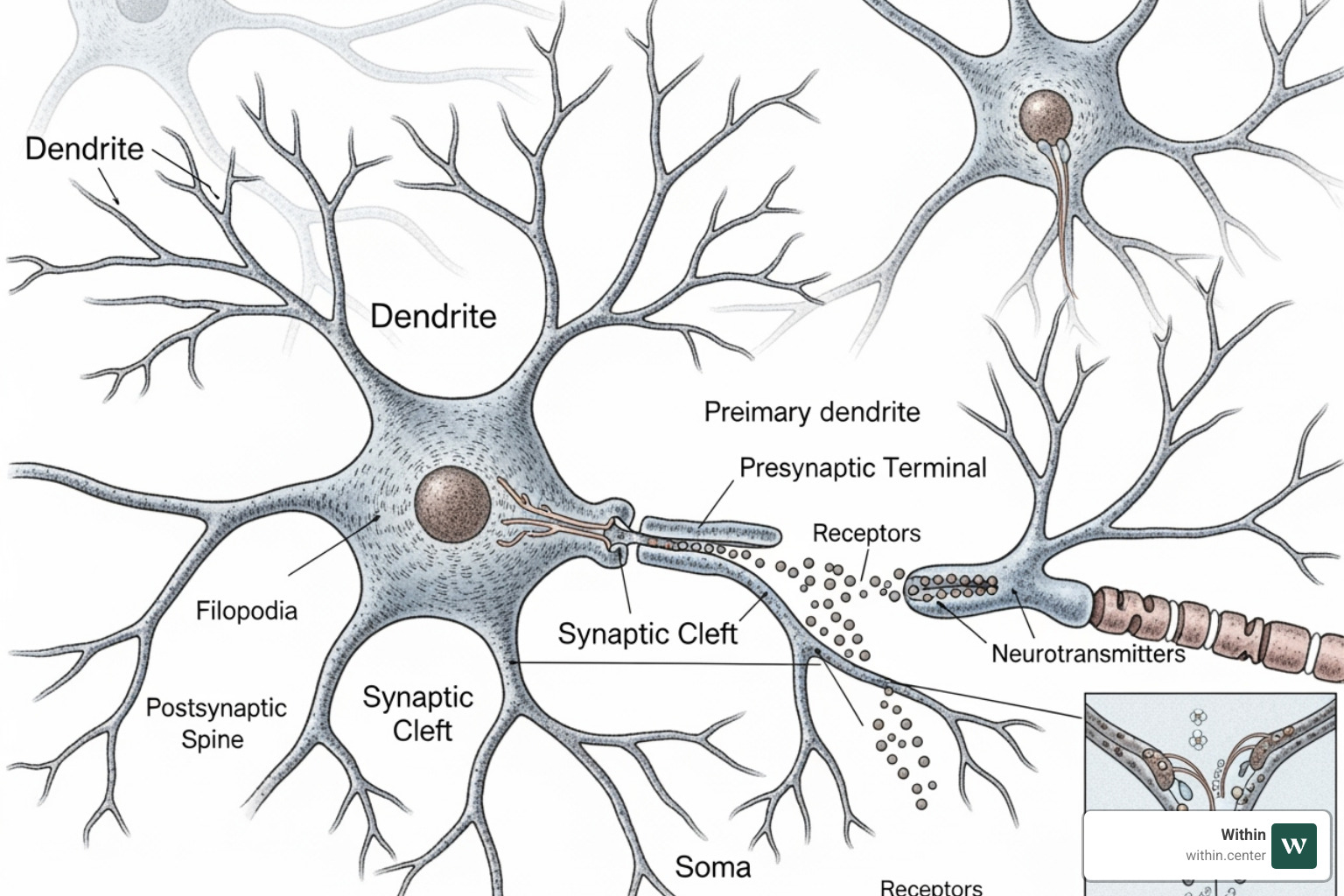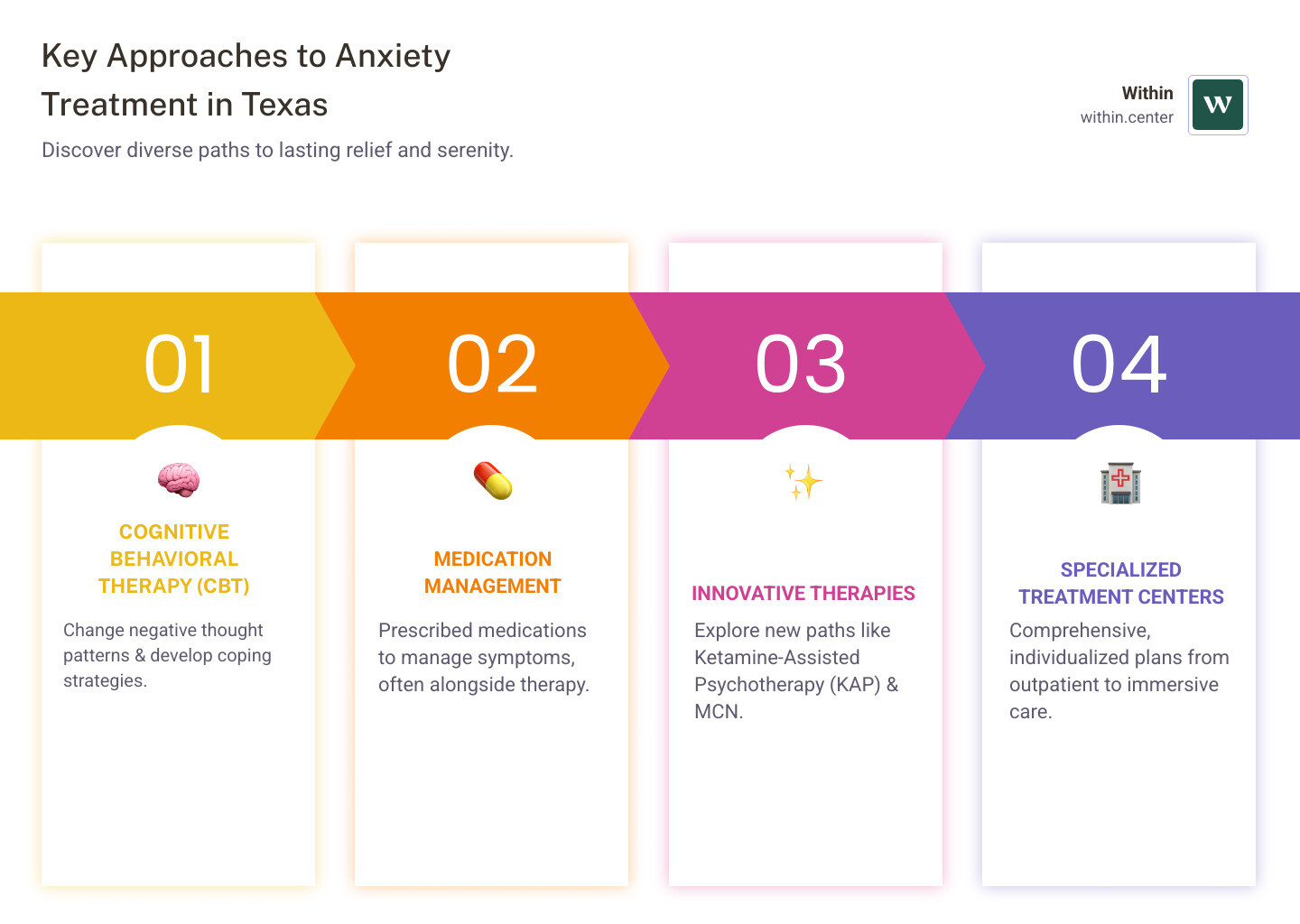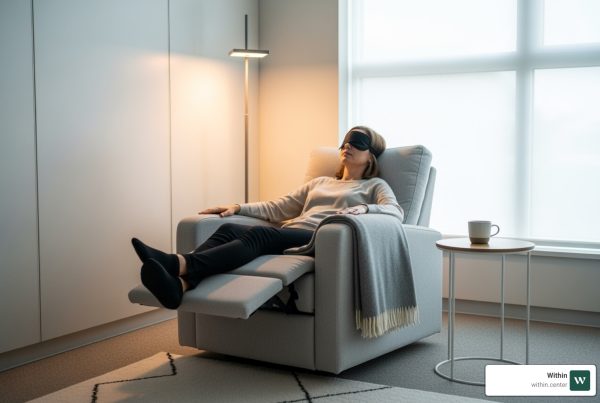
A ketamine treatment program offers hope for treatment-resistant depression, anxiety, PTSD, and other conditions unresponsive to traditional therapies. These programs combine ketamine therapy with psychological support to create lasting change.
Key components of ketamine treatment programs:
- Medical supervision – Licensed physicians oversee treatment and monitor safety
- Multiple administration methods – IV infusion, oral, or sublingual options
- Therapeutic support – Integration sessions to process insights and experiences
- Personalized dosing – Custom to individual weight, medical history, and response
- Structured timeline – Typically 6-8 sessions over 2-3 weeks for initial series
- Ongoing care – Maintenance sessions and long-term support as needed
If traditional treatments haven’t provided lasting relief, you’re not alone. Research shows 22% of people with depression have a treatment-resistant form, for which ketamine offers a new pathway to healing.
Unlike traditional antidepressants, which can take weeks to work, ketamine often brings rapid improvements—sometimes within hours or days. As Dr. Tom Insel noted, ketamine “might be the most important breakthrough in antidepressant treatment in decades.”
The key difference is how ketamine works. Instead of targeting neurotransmitter systems like most psychiatric medications, ketamine blocks NMDA receptors. This promotes neuroplasticity—your brain’s ability to form new connections—creating a “neuroplastic window” where therapy is more effective and lasting change is possible.

Understanding Ketamine Therapy: A New Path to Mental Wellness
Originally an anesthetic from the 1960s, ketamine is now a major breakthrough in mental health. Its unique mechanism of action sets it apart from previous treatments. Most antidepressants, like SSRIs, adjust neurotransmitters such as serotonin. Ketamine is different; it helps the brain build new neural highways.
During therapy, ketamine blocks NMDA receptors. This blockage triggers a release of glutamate, a powerful neurotransmitter that stimulates brain growth. This process boosts brain-derived neurotrophic factor (BDNF), which acts like fertilizer for neurons. BDNF promotes new connections (a process called synaptogenesis), particularly in the prefrontal cortex, which regulates mood and decision-making. This explains ketamine’s rapid effects.

This neuroplastic window—a period of improved brain flexibility—is what makes ketamine-assisted therapy so powerful. It allows for the creation of new, healthier neural pathways, much like forging new trails in a dense forest.
What Conditions Can Ketamine Help Treat?
Initially focused on treatment-resistant depression, clinicians now find ketamine helps a broader range of conditions.
Treatment-resistant depression (TRD) remains its strongest application. For the one in five people with depression who don’t respond to multiple antidepressants, a ketamine treatment program can be life-changing, offering relief in hours or days.
Post-traumatic stress disorder (PTSD) is another condition that responds well. Ketamine creates emotional distance from trauma, allowing for safer processing of difficult memories that were previously inaccessible in therapy.
Anxiety disorders, including generalized anxiety, social anxiety, and panic disorder, often improve as the therapy quiets an overactive nervous system and reduces chronic worry.
Obsessive-compulsive disorder (OCD) shows promising results, with many reporting reduced obsessive thoughts and compulsive behaviors.
Chronic pain conditions, such as fibromyalgia, can also benefit. The neural pathways influencing mood also affect the perception of physical pain.
Bipolar disorder can be treated for depressive episodes, but it requires careful medical supervision and mood stabilization.
The Ways Ketamine is Administered at Within
At Within, your comfort and safety guide our choice of administration methods for your ketamine treatment program.
IV infusion provides precise dosage control. Administered over 40-55 minutes, it allows our medical team to monitor and adjust your dose in real-time, ensuring a consistent experience.
Oral or sublingual lozenges provide a gentler, more gradual onset as they dissolve in the mouth. This method is well-suited to our comfortable, home-like retreat setting.

Every session at Within includes full medical supervision, ensuring you feel safe and supported as you explore the therapeutic potential of your experience.
Who is a Good Candidate for a Ketamine Treatment Program?
Deciding on a ketamine treatment program is a personal choice. At Within, we tailor our approach to your unique health journey. The most common candidates suffer from treatment-resistant depression, having tried at least two antidepressants and therapy without success. This indicates your brain may need a different approach, not that you’ve failed.
We also work with individuals facing severe anxiety, PTSD, or chronic pain who feel stuck with conventional treatments. Your motivation for change is crucial. Ketamine creates opportunities, but success depends on your full engagement in preparation, ketamine sessions, and integration therapy. A comprehensive medical and psychiatric evaluation is required for every participant to ensure ketamine is a safe and appropriate option for your specific health history and needs.
The Harvard Health Blog has excellent information on ketamine for treatment-resistant depression if you want to dive deeper into the research.
Key Benefits and Potential Side Effects
A key benefit of a ketamine treatment program is rapid symptom relief. Unlike traditional antidepressants, ketamine can reduce depressive symptoms within hours or days. This rapid action can be life-saving for those with suicidal thoughts, providing the space needed for deeper therapeutic work.
Ketamine also increases neuroplasticity, creating fertile ground for new, healthier thought patterns. Patients often report feeling more open, creative, and hopeful after treatment.
Temporary side effects can occur. Dissociation, a feeling of detachment, is common and often a profound part of the therapeutic process. Mild nausea is manageable with medication, and we continuously monitor for temporarily increased blood pressure and heart rate. The altered state of consciousness can include vivid imagery and shifts in perception, which often yield valuable insights. Impaired motor coordination lasts for about 24 hours, so driving is prohibited. Long-term side effects are rare with controlled, therapeutic doses.
Contraindications: Who Should Avoid Ketamine Therapy?
Your safety is our priority. Our thorough screening identifies contraindications to ensure ketamine is a safe choice for you.
Ketamine is unsuitable for individuals with:
- Active psychosis or mania, as symptoms can worsen.
- Uncontrolled high blood pressure, as ketamine temporarily raises it.
- Certain heart conditions, such as a recent heart attack or unstable angina.
- Pregnancy and breastfeeding, due to a lack of safety research.
- Severe liver or kidney disease, which can impair processing the medication.
- Allergies to ketamine or related compounds.
Careful consideration is required for those with recent substance use disorders. Other potential contraindications include uncontrolled thyroid issues, recent seizures, or unstable glaucoma. Medication interactions, especially with MAOIs, can be dangerous, so a complete medication list is required. This screening ensures we find the safest, most effective path for you.
The Role of Therapy in a Ketamine Treatment Program
Ketamine isn’t a magic bullet. While it rapidly lifts symptoms, real, lasting change comes from combining it with dedicated therapy. This is the principle behind Ketamine-Assisted Psychotherapy (KAP), the focus of our ketamine treatment programs.
Ketamine creates a “neuroplastic window”—a period when the brain is more flexible and open to new connections. This state makes it easier to reshape thoughts and behaviors that have been stuck for years. This window is temporary, so without therapeutic support to process insights and build new patterns, you risk returning to old ways. Therapy is therefore essential. Our therapists support you at every stage: setting intentions, providing a safe presence during sessions, and guiding you through integration afterward.

As we explore in our article Why Ketamine Alone Isn’t Enough, lasting healing requires more than a chemical shift; it demands understanding, processing, and building new habits.
What to Expect from a Ketamine Treatment Program
Starting a ketamine treatment program can feel daunting, but our process is designed to be comfortable and supportive.
Your journey starts with preparation sessions where we discuss your goals, explain the process, and help you set intentions. During dosing sessions, you’ll be in a peaceful space, supported by our medical team who monitor your vitals. The ketamine experience is unique to each person, often involving a meditative state with profound insights. Painful memories may lose their sting, allowing you to examine them with curiosity. Active effects last 45-90 minutes, but the work continues in integration sessions, where we help you unpack your experience and apply it to your life.
Here’s how a ketamine treatment program compares to traditional depression treatments:
| Feature | Ketamine Therapy Program | Traditional Antidepressants |
| Speed of Relief | Often works within hours or days | Usually takes 4-8 weeks to notice effects |
| How It Works | Blocks NMDA receptors, promotes new brain connections | Adjusts serotonin and other neurotransmitter levels |
| Treatment Style | Structured series of sessions with intensive therapy support | Daily pills, often taken long-term |
| The Experience | Can involve profound insights and altered states of consciousness | Gradual mood stabilization without dramatic experiences |
| Therapy Component | Deeply integrated – therapy is essential for processing insights | Therapy is helpful but separate from how the medication works |
For real stories about what these experiences are like, check out Ketamine Therapy Experiences: Real Voices and Expert Insight. Every person’s journey is unique, but our comprehensive approach ensures you’re supported through every moment.
Why Integration is the Key to Lasting Change
If ketamine creates fertile ground, integration is the work that helps new insights grow into lasting change. It transforms temporary insights into permanent lifestyle shifts.
Our comprehensive integration approach includes:
- Therapeutic support: Experienced therapists help you make sense of your experience.
- Community connection: At our retreat, sharing with others on a similar path provides powerful support.
- Somatic practices: Movement and breathwork help release stored tension.
- Journaling and mindfulness: These tools help cement insights and stay present.
- Developing new habits: We help you build healthier stress responses and communication skills during this neuroplastic state.
As we discuss in How Important is the Therapy Component of Ketamine Therapy?, the therapy component is what makes the difference between temporary relief and lasting change. Our goal isn’t just to help you feel better for a few weeks. We want to help you build a foundation for long-term wellbeing and resilience.
Navigating the Practicalities of Ketamine Treatment
Choosing a ketamine treatment program involves practical considerations like cost and insurance. We’re here to simplify this for you.
The reality is that ketamine for mental health is still considered “off-label” by the FDA (except for Spravato), so most insurance plans don’t cover it. Most programs are cash-pay. However, associated services like medical consultations and therapy sessions may be reimbursable. We provide superbills for reimbursement that you can submit to your insurance for potential out-of-network coverage. Financing options like CareCredit can also make the investment more accessible. Our team can help you explore these options.
Finding the Right Ketamine Treatment Program for You
Choosing the right ketamine treatment program is a big decision. With many options available, the key is finding an approach that feels right for you.
At Within, our immersive retreat experience at AWKN Ranch near Austin offers a unique alternative to standard clinic visits. This live-in model provides constant support in an environment designed for deep, lasting change.
When exploring programs, prioritize:
- Medical supervision: Ensure qualified professionals oversee your care and safety.
- Therapeutic support: Effective programs integrate ketamine with psychotherapy, including preparation and integration.
- A holistic approach: Look for programs that include elements like mindfulness, somatic work, and community.
- Experience and reputation: Research the provider, ask about success rates, and read testimonials.
- The environment: The setting is impactful. Ketamine creates a vulnerable state, so feeling safe is paramount. Our peaceful ranch setting provides a nurturing backdrop for deep healing.

Finding the right program means finding the right partners. Our immersive retreat model offers a comprehensive, community-focused approach for genuine change.
Frequently Asked Questions about Ketamine Programs
Considering a ketamine treatment program brings up common questions about speed, safety, and lasting benefits. Let’s explore the answers.
How quickly does ketamine therapy work for depression?
A remarkable aspect of ketamine therapy is its speed. Unlike traditional antidepressants, it often brings relief within hours to days of the first session. Research shows significant improvement in depression and suicidal thoughts within hours. However, the most significant and lasting results come from a full ketamine treatment program with multiple sessions and integration. The initial relief opens a door; therapy helps you walk through it.
Is ketamine therapy addictive?
This is a common and valid concern. While ketamine has misuse potential, the risk of addiction is low when used in a controlled, clinical setting. Our approach minimizes risk. We use controlled, sub-anesthetic doses in a structured program. Our team screens all candidates for substance use history, and you are professionally supervised at all times. The intermittent use in therapy, unlike daily recreational use, also reduces addiction risk.
How long do the benefits of a ketamine treatment program last?
This varies, but the initial antidepressant effects of the medication typically last from days to weeks. Our goal, however, is sustainable improvement. Our comprehensive ketamine treatment program with Ketamine-Assisted Psychotherapy (KAP) uses the neuroplastic window to help you build new thought patterns and coping skills. Many participants opt for maintenance programs—periodic sessions that solidify and extend their progress for long-term success. The key is that ketamine opens the door, while integration builds the foundation for lasting well-being.
Conclusion: A Doorway to Deeper Healing
If traditional approaches haven’t worked, your healing journey isn’t over. A ketamine treatment program offers a genuine breakthrough, combining neuroscience with therapeutic and community support.
Ketamine’s power isn’t just its rapid effects on conditions like depression and PTSD. It’s the neuroplastic window it creates, making the brain flexible and open to change. This allows therapeutic work to create lasting change that was previously out of reach.
We’ve learned that ketamine alone isn’t enough. The real magic requires a supportive container: experienced professionals, a safe environment, and a community of peers who understand. Our immersive retreat experience at AWKN Ranch near Austin provides this healing environment. You get the time and space to integrate your experiences, surrounded by nature, our team, and a supportive community focused on holistic well-being.
The future of mental health is changing. Psychedelic therapy offers new hope, but it’s not a quick fix. It’s about using powerful tools thoughtfully, with proper support, to build the life you actually want to live.
If you’re ready to explore what’s possible beyond conventional treatment, we’re here to support you. This could be the doorway to deeper healing you’ve been looking for. Learn more about our approach in The Doorway In: How Psychedelic Therapy and Community Care are Changing Mental Health and take the next step by exploring our ketamine retreat programs.
Your healing journey is waiting. And you don’t have to walk it alone.
Find serenity with expert anxiety treatment Texas. Explore traditional & innovative therapies to personalize your path to wellness.

Anxiety treatment Texas offers a wide range of options for those seeking relief and lasting wellness. If you’re looking for help right now, here are key approaches available:
- Cognitive Behavioral Therapy (CBT): A leading evidence-based therapy that helps you change negative thought patterns.
- Medication Management: Prescription medications can help manage symptoms, often alongside therapy.
- Innovative Therapies: Options like Ketamine-Assisted Psychotherapy (KAP) and Microcurrent Neurofeedback (MCN) offer new paths for healing.
- Specialized Centers: Texas has dedicated facilities providing comprehensive, individualized treatment plans, from outpatient to immersive programs.
Anxiety is the most common mental illness in the United States, affecting nearly a third of all adults. For many, constant worry and fear can make even simple daily activities tough. It can disrupt sleep, impact relationships, and make you feel stuck in a fog.
But there’s good news. Millions of Texans have found effective help. You don’t have to face anxiety alone. This guide will walk you through the many effective treatment options available across the state. It’s about finding the right path to help you regain control and find lasting serenity.

Nearly everyone experiences anxiety at some point. That knot in your stomach before a big presentation or the stress of a looming deadline are normal responses that help us stay safe. But for some, these feelings become intense and unmanageable, crossing the line from a normal emotion to a clinical anxiety disorder.

In an anxiety disorder, symptoms are so severe they make daily activities difficult or impossible. This persistent state of apprehension leads to a range of emotional and physical symptoms. Emotionally, you might feel overwhelming fear, worry, irritability, and have trouble focusing. Physically, your body might react with a rapid heartbeat, sweating, shortness of breath, muscle tension, nausea, and sleep problems. These symptoms can disrupt work, relationships, and your overall ability to function.
To learn more about the specifics, you can visit the National Institute of Mental Health’s page on What are anxiety disorders?.
What are the Different Types of Anxiety Disorders?
Anxiety isn’t a one-size-fits-all condition; it manifests in various forms. Understanding these types is the first step toward finding the right anxiety treatment Texas.
Here are some of the most common anxiety disorders:
- Generalized Anxiety Disorder (GAD): This involves persistent, excessive worry about everyday things, often without a clear reason.
- Panic Disorder and Panic Attacks: This involves recurrent, unexpected panic attacks—sudden, intense episodes of fear with severe physical reactions. These attacks can feel terrifying, like you’re losing control or having a heart attack. Agoraphobia often co-occurs.
- Social Anxiety Disorder (Social Phobia): This is an intense fear of social situations due to fear of being judged, embarrassed, or humiliated, leading to avoidance of social events.
- Specific Phobias: This is an intense, irrational fear of a specific object or situation (like heights or flying) that is disproportionate to the actual danger.
- Obsessive-Compulsive Disorder (OCD): While now classified separately, OCD often involves anxiety-provoking obsessive thoughts and compulsive behaviors. Many anxiety treatment programs still address OCD due to the strong symptom overlap.
- Post-Traumatic Stress Disorder (PTSD): Also now classified separately, PTSD can develop after a terrifying event. Symptoms include flashbacks, nightmares, and severe anxiety. Treatment programs for anxiety often address PTSD due to the significant anxiety component.
Common Signs You May Need Professional Help
Recognizing the signs is a brave first step. If you experience any of the following persistently, it might be time to seek professional anxiety treatment Texas:
- Constant Worry: You worry constantly about things, even if they haven’t happened, and it feels uncontrollable and exhausting.
- Overwhelming Fear: You feel intense, persistent fear that is disproportionate to the situation.
- Increased Heart Rate and Physical Symptoms: Your body is on high alert, with physical symptoms like a rapid heart rate, sweating, shortness of breath, muscle tension, or nausea.
- Difficulty Sleeping: You have trouble falling or staying asleep, which can make anxiety worse.
- Avoiding Social Situations: You avoid activities or social gatherings you once enjoyed due to fear or self-consciousness.
- Trouble Concentrating: The constant worry makes it hard to focus on work, school, or conversations.
When anxiety symptoms interfere with your work, relationships, and overall happiness, professional support can make a profound difference. You can find more information on common symptoms of anxiety from the Mayo Clinic: Common symptoms of anxiety.
Navigating Anxiety Treatment in Texas: From Traditional to Innovative Approaches
Starting on the journey of anxiety treatment Texas means finding a whole spectrum of helpful approaches. Our goal isn’t just to manage symptoms, but to equip you with long-term skills, help you cope with triggers, and ultimately guide you toward a healthier, more fulfilling life. Often, the most effective path involves combining different therapies, all personalized to your unique needs and goals.

Foundational Therapies for Lasting Relief
When it comes to effective anxiety treatment Texas, some therapeutic approaches truly stand out for their proven results. These are often the first steps and form the strong foundation for many people’s recovery journeys.
One cornerstone is Psychotherapy, often known as Talk Therapy. This involves working with a trained mental health professional to explore the roots of your worries, understand your patterns, and develop healthier ways to cope. It’s about gaining deep insights and building inner strength.
Cognitive Behavioral Therapy (CBT) is considered the “gold standard” for anxiety treatment. This research-backed therapy is based on the connection between our thoughts, feelings, and behaviors. CBT helps you identify and change unhelpful thought patterns, like catastrophizing, and replace them with more realistic ones. It often includes exposure therapy—gradually facing feared situations in a safe environment to build confidence. Many people find significant relief within 8 to 12 weeks. You can explore more about the research behind CBT for anxiety here: Research on CBT for anxiety.
Finally, Mindfulness-Based Therapy brings in practices that focus on being fully in the present moment, without judgment. It teaches you to observe anxious thoughts and feelings without getting caught up in them, which can significantly reduce the intensity of your symptoms.
The Role of Medication in Anxiety Management
For many, medication is a crucial part of a comprehensive anxiety treatment Texas plan, especially for severe symptoms. It’s most effective when combined with psychotherapy.
Medication for anxiety is prescribed and managed by a psychiatrist, who can assess your needs and find the right type and dosage. Common medications include antidepressants (like SSRIs) for long-term management and benzodiazepines (like Xanax) for short-term relief of severe anxiety. Medication management involves regular check-ups to monitor effectiveness and side effects. The goal is to use medication as a tool to ease symptoms so you can fully engage in therapy and build lasting coping skills.
Innovative and Psychedelic-Assisted Therapies at Within
At Within, we are dedicated to offering cutting-edge anxiety treatment Texas options, especially for those who haven’t found relief through traditional methods. We believe in using neuroscience and holistic healing to open doors to profound change.
One of our key offerings is Ketamine-Assisted Psychotherapy (KAP), which combines low-dose ketamine with structured psychotherapy. Ketamine promotes neuroplasticity—the brain’s ability to form new, healthy connections. This “rewiring” of neural pathways creates a unique window for deeper therapeutic work, helping unconscious feelings surface and making therapy more effective. KAP can accelerate healing for tough-to-treat anxiety, depression, and PTSD, with results often felt in weeks, not years. You can dig deeper into this exciting therapy on our dedicated page: What is Ketamine Therapy?.
Another groundbreaking approach we use is Microcurrent Neurofeedback (MCN). This therapy gently applies brief microcurrent stimulation to encourage your brain and nervous system to reorganize themselves. MCN helps “disentrain” the nervous system, leading to better brainwave harmony and improved mental well-being. It’s been shown to help with anxiety, OCD, depression, and PTSD. Many clients notice positive changes in as few as 1 to 3 sessions.
We strongly emphasize that while these innovative therapies are powerful, the therapy component is essential. The insights gained are most effectively sustained when processed within a supportive therapeutic framework. This integration is the key to turning temporary relief into lasting change. Learn more about The importance of the therapy component.

Choosing Your Path to Wellness in Texas
Navigating the myriad of options for anxiety treatment Texas can feel overwhelming, but finding the right fit is crucial for your healing journey. Your path to wellness should be as unique as you are, custom to your specific needs, preferences, and lifestyle.
At Within, we understand that true healing goes beyond symptom management. That’s why we offer an immersive, live-in retreat experience at AWKN Ranch near Austin, Texas, coupled with comprehensive integration support and a strong community focus. This contrasts with traditional outpatient models, providing a deeply holistic approach to well-being.
Here’s a comparison of outpatient care versus our immersive retreat model:
| Feature | Outpatient Treatment | Immersive Retreat Treatment (e.g., Within) |
| Setting | Clinic visits, remote sessions, daily life continues | Dedicated, supportive, residential environment |
| Intensity | Weekly/bi-weekly sessions, self-managed outside sessions | Full-time, structured program with constant support |
| Focus | Symptom management, skill-building | Holistic healing, deep change, integration |
| Environment | Daily stressors remain, requires self-discipline | Removed from triggers, dedicated to healing |
| Community | Limited peer interaction, individual focus | Strong community bonds, shared healing journey |
| Integration Support | Often limited to therapy sessions | Comprehensive, ongoing support post-retreat |
| Ideal For | Mild-moderate anxiety, maintaining daily routine | Chronic/complex anxiety, desire for deep, rapid change |
What to Look for in an Anxiety Treatment Center
When seeking anxiety treatment Texas, choose a center that resonates with your values. Here’s what we believe you should prioritize:
- Specialized Clinicians: Seek centers with anxiety specialists, not just generalists. Their deep understanding of anxiety disorders and effective interventions can significantly improve your treatment quality.
- Evidence-Based Practices: Ensure the center uses treatments backed by research, such as CBT, Mindfulness-Based Therapy, and, where appropriate, innovative therapies like KAP or MCN.
- Individualized Treatment Plans: A good center will conduct a thorough assessment and develop a personalized treatment plan custom to your unique needs, goals, and severity of anxiety.
- Holistic Approach: Effective treatment addresses the whole person—mind, body, and spirit. Look for centers offering a comprehensive approach with therapy, wellness education, and stress management. At Within, our immersive retreat provides holistic healing and comprehensive integration support to ensure lasting well-being within a supportive community.
- Environment and Setting: The treatment environment plays a significant role in healing. Look for a setting that feels safe, supportive, and conducive to recovery, whether it’s a calming clinic or an immersive retreat like our AWKN Ranch.
Our team of experts at Within is dedicated to providing compassionate, individualized, and effective care. You can learn more about the passionate professionals guiding our programs here: Our Team of experts.
Specialized Anxiety Treatment in Texas for Different Age Groups
Anxiety treatment needs can vary across life stages. Anxiety treatment Texas offers specialized programs to meet these unique needs.
- Children’s Programs: For children, anxiety can appear as excessive worry or school refusal. Treatment often involves play therapy, family therapy, and age-appropriate CBT to manage fears.
- Adolescent Support: Teens face unique pressures fueling anxiety. Programs focus on coping skills, self-esteem, and social anxiety, often using individual, group, and family therapy.
- Adult-Focused Care: Adult programs address the full spectrum of anxiety disorders, incorporating individual and group therapy, medication management, and stress management techniques.
- Senior Anxiety: Anxiety in older adults can be overlooked. Programs for seniors focus on coping with life transitions, managing chronic health conditions, and reducing social isolation.
- Family Involvement: Family involvement is often key to successful healing. Many centers offer family therapy or educational groups to help loved ones understand the disorder and provide effective support.
How to Handle Insurance and Payment in Texas
Navigating the financial aspects of anxiety treatment Texas can be stressful, but understanding your options can help.
- Verifying Benefits: First, contact your insurance company to verify your mental health benefits. Ask about deductibles, co-pays, and out-of-pocket maximums for specific services like therapy or specialized programs.
- In-Network vs. Out-of-Network: Check if a provider is in-network with your insurance. In-network providers usually mean lower out-of-pocket costs. Out-of-network providers may still be partially covered.
- Private Pay Options: Many choose to self-pay for more flexibility and privacy, especially for innovative treatments not always covered by insurance.
- Financing Plans: Some centers offer financing options like CareCredit to make treatment more accessible. Ask providers about payment plans or financing solutions.
Frequently Asked Questions about Anxiety Treatment
Starting the journey toward anxiety treatment Texas naturally brings up many questions. Let’s address the most common ones.
How long does anxiety treatment typically take?
The duration of treatment is unique to each person, depending on the type of anxiety and the chosen approach. With therapies like Cognitive Behavioral Therapy (CBT), many feel meaningful relief within 8-12 weeks.
However, the goal of effective anxiety treatment Texas is to develop lasting skills, not just quick symptom relief. Some benefit from short, intensive programs, while others need longer-term support. The investment in treatment provides long-term benefits for your well-being.
What is the first step to getting help for anxiety in Texas?
Taking the first step is simpler than it seems. While self-assessments can be helpful, the most valuable action is to schedule an initial consultation with a mental health professional.
In this conversation, you can share your experiences and receive expert guidance. A professional can determine if you have clinical anxiety, identify the type, and create a personalized treatment plan. Reaching out is a sign of strength. If you’re ready, you can Contact us for a consultation to begin your healing journey.
Can anxiety be cured completely?
Anxiety is typically not “cured” in the traditional sense, but it can be effectively managed. Effective anxiety treatment Texas focuses on reducing the frequency and intensity of symptoms and developing powerful coping skills.
Treatment teaches you to manage anxiety so it no longer controls your life, becoming more like background noise than a constant alarm. With the right tools and support, you can live a full, joyful, and productive life. Lasting relief means having the freedom to thrive.
Conclusion: Your Journey to Serenity Starts Here
What a journey we’ve been on together! We’ve explored the ins and outs of anxiety, from understanding its many forms to finding the wide world of anxiety treatment Texas has to offer. It’s clear that feeling overwhelmed by worry is something many of us experience. But, just as clearly, hope and effective solutions are abundant. You truly don’t have to face this alone.
The power of professional help can’t be overstated. Imagine finding relief through proven paths like Cognitive Behavioral Therapy (CBT), or finding how medication can help calm the storm. Perhaps cutting-edge options like Ketamine-Assisted Psychotherapy (KAP) or Microcurrent Neurofeedback (MCN) could be your path to profound healing. The key is finding a specialized center that offers personalized, holistic care, understanding that everyone’s journey is unique.
Taking that first step, reaching out for help, is one of the bravest acts of self-love you can make. It’s about acknowledging your struggles and committing to your own well-being. Here at Within, we are deeply committed to providing an immersive, live-in retreat experience at our beautiful AWKN Ranch. It’s designed for holistic healing within a supportive community, focusing on deep, lasting change with robust integration support. We believe this comprehensive approach nurtures your mind, body, and spirit, helping you build a truly serene future.
Your journey to a calmer, more fulfilling life truly starts now. Don’t let anxiety hold you back any longer. We invite you to explore the possibilities and take that vital first step toward reclaiming your peace.
Begin your healing journey with Psychedelic Therapy in Austin




